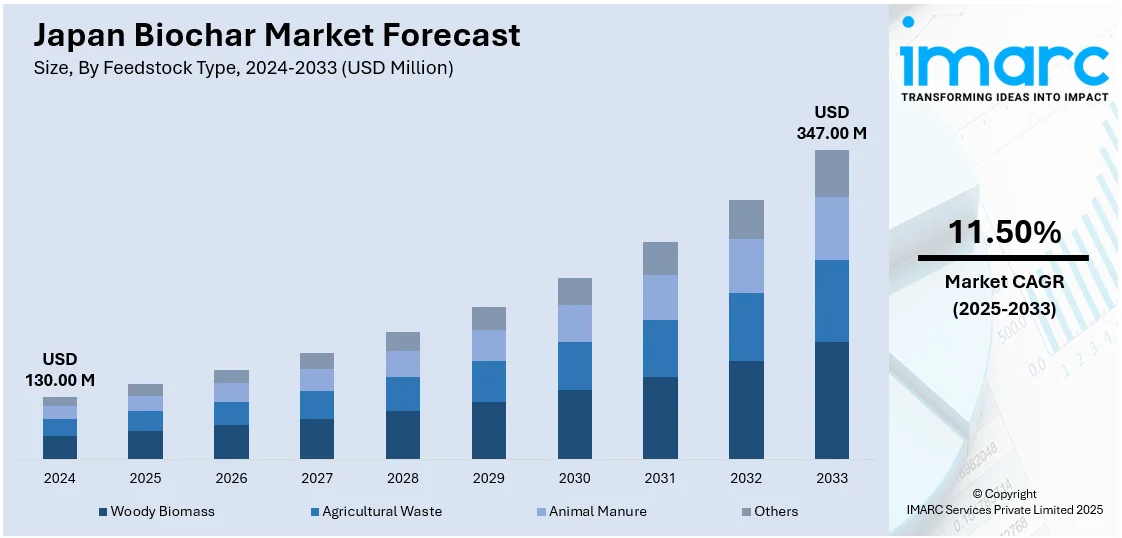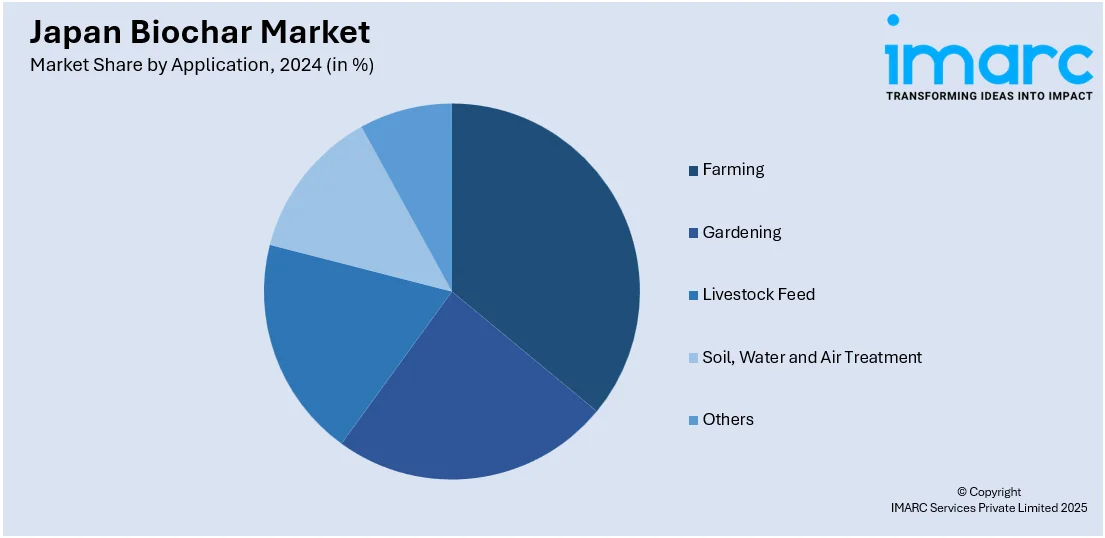
Japan Biochar Market Size, Share, Trends and Forecast by Feedstock Type, Technology Type, Product Form, Application, and Region, 2025-2033
Japan Biochar Market Overview:
The Japan biochar market size reached USD 130.00 Million in 2024. Looking forward, IMARC Group expects the market to reach USD 347.00 Million by 2033, exhibiting a growth rate (CAGR) of 11.50% during 2025-2033. The market is driven by expanding carbon sequestration initiatives, increasing government support for sustainable agriculture, rising demand for soil enhancement, growing waste-to-resource innovations, increasing climate change mitigation efforts, expanding organic farming, and surging interest in circular economy practices.
|
Report Attribute
|
Key Statistics
|
|---|---|
|
Base Year
|
2024 |
|
Forecast Years
|
2025-2033
|
|
Historical Years
|
2019-2024
|
| Market Size in 2024 | USD 130.00 Million |
| Market Forecast in 2033 | USD 347.00 Million |
| Market Growth Rate 2025-2033 | 11.50% |
Japan Biochar Market Trends:
Integration of Biochar in Sustainable Agriculture Practices
The integration of biochar into sustainable agriculture practices is boosting the Japan biochar market share, due to the rising environmental problems, combined with the need for agricultural optimization. In line with this, Biochar continues to benefit soil fertility and water retention, and carbon sequestration, thus supporting the dual goals of greenhouse gas (GHG) emission reduction and eco-friendly farming techniques across the region. For example, in June 2024, three Japanese companies launched a demonstration project utilizing biochar to cut greenhouse gas emissions in agriculture. This aligns with Japan's 'Green Food System Strategy' aimed at achieving net-zero GHG emissions in the agricultural sector. Additionally, modern farmers adopt biochar technologies because they understand how the practice builds sustainable soil quality and increases agricultural yields. Furthermore, the enhancement of sustainable agricultural practices along with environmental stewardship receives backing through government initiatives, which strongly promote these practices. Apart from this, the expanding awareness about biochar advantages is supporting its agricultural usage in the region, creating a sustainable and resilient agricultural system.

Technological Advancements in Biochar Production
The ongoing advancements in biochar production are significantly enhancing the Japan biochar market outlook. In addition to this, the improvement of pyrolysis and gasification technologies has brought about economical and efficient approaches to produce high-quality biochar. Moreover, the improved technologies increase both the production capacity and the product quality stability of biochar manufacturing methods. For instance, in October 2024, Towing Co., Ltd., a Japanese biotechnology startup, commenced mass production of biochar at its new facility in Toyohashi, central Japan. This initiative enhances the availability of high-quality biochar for agricultural applications, promoting sustainable farming practices and exemplifying the growing industrial scalability in the sector. Concurrently, the appeal and application of biochar among local farmers in Japan also increases through researcher and company investments into developing customized biochar products for different soil types and farming requirements. In confluence with this, the optimization process for producing biochar from different biomass feedstocks, such as agricultural residues and forestry waste, helps reduce waste while enhancing resource efficiency. As a result, the market is experiencing an increased expansion because new technological strategies are enhancing the sustainability of production and optimizing the effectiveness of final products for agricultural needs, thereby driving the Japan biochar market forward.
Japan Biochar Market Segmentation:
IMARC Group provides an analysis of the key trends in each segment of the market, along with forecasts at the region level for 2025-2033. Our report has categorized the market based on feedstock type, technology type, product form, and application.
Feedstock Type Insights:
- Woody Biomass
- Agricultural Waste
- Animal Manure
- Others
The report has provided a detailed breakup and analysis of the market based on the feedstock type. This includes woody biomass, agricultural waste, animal manure, and others.
Technology Type Insights:
- Slow Pyrolysis
- Fast Pyrolysis
- Gasification
- Hydrothermal Carbonization
- Others
A detailed breakup and analysis of the market based on the technology type have also been provided in the report. This includes slow pyrolysis, fast pyrolysis, gasification, hydrothermal carbonization, and others.
Product Form Insights:
- Coarse and Fine Chips
- Fine Powder
- Pellets, Granules and Prills
- Liquid Suspension
The report has provided a detailed breakup and analysis of the market based on the product form. This includes coarse and fine chips, fine powder, pellets, granules and prills, and liquid suspension.
Application Insights:

- Farming
- Gardening
- Livestock Feed
- Soil, Water and Air Treatment
- Others
A detailed breakup and analysis of the market based on the application have also been provided in the report. This includes farming, gardening, livestock feed, Soil, Water and Air Treatment, and others.
Regional Insights:
- Kanto Region
- Kansai/Kinki Region
- Central/Chubu Region
- Kyushu-Okinawa Region
- Tohoku Region
- Chugoku Region
- Hokkaido Region
- Shikoku Region
The report has also provided a comprehensive analysis of all the major regional markets, which include Kanto Region, Kansai/Kinki Region, Central/Chubu Region, Kyushu-Okinawa Region, Tohoku Region, Chugoku Region, Hokkaido Region, and Shikoku Region.
Competitive Landscape:
The market research report has also provided a comprehensive analysis of the competitive landscape. Competitive analysis such as market structure, key player positioning, top winning strategies, competitive dashboard, and company evaluation quadrant has been covered in the report. Also, detailed profiles of all major companies have been provided.
Japan Biochar Market News:
- In February 2025, Nomura Securities Co., Ltd. and Shonaikomekobo Corporation entered into an MOU to manufacture biochar from rice husks in order to improve soil quality and carbon sequestration. This initiative promotes sustainable agriculture and contributes to decarbonization efforts in Japan.
- In April 2023, Marubeni Corporation entered into a business alliance with PROS Co., Ltd. to manufacture and sell rice husk biochar. The collaboration focuses on increasing production capacities and utilizing biochar for various applications, including soil improvement and carbon sequestration, thereby advancing the circular economy.
Japan Biochar Market Report Coverage:
| Report Features | Details |
|---|---|
| Base Year of the Analysis | 2024 |
| Historical Period | 2019-2024 |
| Forecast Period | 2025-2033 |
| Units | Million USD |
| Scope of the Report | Exploration of Historical Trends and Market Outlook, Industry Catalysts and Challenges, Segment-Wise Historical and Future Market Assessment:
|
| Feedstock Types Covered | Woody Biomass, Agricultural Waste, Animal Manure, Others |
| Technology Types Covered | Slow Pyrolysis, Fast Pyrolysis, Gasification, Hydrothermal Carbonization, Others |
| Product Forms Covered | Coarse and Fine Chips, Fine Powder, Pellets, Granules and Prills, Liquid Suspension |
| Applications Covered | Farming, Gardening, Livestock Feed, Soil, Water and Air Treatment, Others |
| Regions Covered | Kanto Region, Kansai/Kinki Region, Central/Chubu Region, Kyushu-Okinawa Region, Tohoku Region, Chugoku Region, Hokkaido Region, Shikoku Region |
| Customization Scope | 10% Free Customization |
| Post-Sale Analyst Support | 10-12 Weeks |
| Delivery Format | PDF and Excel through Email (We can also provide the editable version of the report in PPT/Word format on special request) |
Key Questions Answered in This Report:
- How has the Japan biochar market performed so far and how will it perform in the coming years?
- What is the breakup of the Japan biochar market on the basis of feedstock type?
- What is the breakup of the Japan biochar market on the basis of technology type?
- What is the breakup of the Japan biochar market on the basis of product form?
- What is the breakup of the Japan biochar market on the basis of application?
- What is the breakup of the Japan biochar market on the basis of region?
- What are the various stages in the value chain of the Japan biochar market?
- What are the key driving factors and challenges in the Japan biochar?
- What is the structure of the Japan biochar market and who are the key players?
- What is the degree of competition in the Japan biochar market?
Key Benefits for Stakeholders:
- IMARC’s industry report offers a comprehensive quantitative analysis of various market segments, historical and current market trends, market forecasts, and dynamics of the Japan biochar market from 2019-2033.
- The research report provides the latest information on the market drivers, challenges, and opportunities in the Japan biochar market.
- Porter's five forces analysis assist stakeholders in assessing the impact of new entrants, competitive rivalry, supplier power, buyer power, and the threat of substitution. It helps stakeholders to analyze the level of competition within the Japan biochar industry and its attractiveness.
- Competitive landscape allows stakeholders to understand their competitive environment and provides an insight into the current positions of key players in the market.
Need more help?
- Speak to our experienced analysts for insights on the current market scenarios.
- Include additional segments and countries to customize the report as per your requirement.
- Gain an unparalleled competitive advantage in your domain by understanding how to utilize the report and positively impacting your operations and revenue.
- For further assistance, please connect with our analysts.
 Request Customization
Request Customization
 Speak to an Analyst
Speak to an Analyst
 Request Brochure
Request Brochure
 Inquire Before Buying
Inquire Before Buying




.webp)




.webp)












